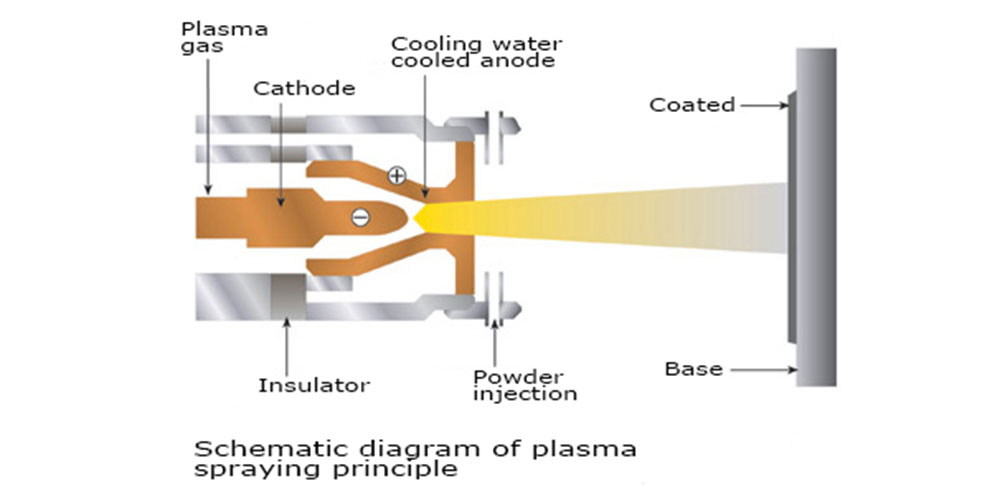Overview of plasma spraying process:
Plasma spraying is an advanced thermal spraying technology that uses the high temperature and high-speed airflow of plasma to spray coating materials onto the surface of the substrate to form a uniform, dense, and high-quality coating. This technology has ultra-high temperature characteristics, is suitable for spraying high melting point materials, and can achieve high density and high bonding strength of the coating.
Advantages of plasma spraying
(1) The base body is heated less and the parts are not deformed: Since the parts are not charged during spraying, the base metal does not melt, so the heat treatment properties of the base metal will not change, and some high-strength steel materials can be sprayed.
(2) Various types of materials and rich coating properties: Plasma spraying can use a variety of materials, including metals, ceramics, plastics, etc., so coatings with various properties can be obtained, such as wear-resistant coatings, heat-insulating coatings, and high-temperature resistant coatings. Oxide coating, insulating coating, etc.
(3) Stable process and high coating quality: The process parameters of plasma spraying can be quantitatively controlled, the process is stable, the coating reproducibility is good, and the bonding strength between the coating and the substrate is high.
The process parameters of plasma spraying include the selection of plasma gas, arc power, powder feeding amount, spraying distance and spraying angle, etc. Proper setting of these parameters is crucial to the quality of the coating. For example, the choice of plasma gas will affect the enthalpy and flow rate of the coating, the power of the arc will affect the temperature of the coating and the degree of melting of the particles, and the powder feeding amount and spraying distance will affect the deposition efficiency and uniformity of the coating. sex.
Plasma spraying technology is widely used in aerospace, automotive, electronics, medical and other fields. In the aerospace field, high-temperature alloys, ceramic coatings, etc. can be sprayed to improve the heat resistance of engines, turbines and other components; in the automotive field, anti-corrosion coatings, ceramic coatings, etc. can be sprayed to improve the corrosion resistance of automobile parts; In the electronics field, conductive coatings, insulating coatings, etc. can be sprayed to improve the performance and reliability of electronic components.

What types of plasma gases are commonly used in plasma spraying processes?
In the plasma spraying process, commonly used plasma gases mainly include the following types:
Hydrogen (H2): Hydrogen is a diatomic gas with high thermal conductivity and can significantly increase the temperature and thermal power of the plasma arc. Hydrogen is an indispensable gas when spraying refractory materials and ceramic materials. However, hydrogen is difficult to prepare and preserve, is costly, and poses certain safety risks, so its use is limited in some cases.
Nitrogen (N2): Nitrogen is also a diatomic gas with a high thermal enthalpy value. It absorbs a lot of heat during the ionization process and has a high energy utilization rate. Nitrogen is widely used in plasma spraying because of its convenient source and low price. However, nitrogen has certain oxidizing properties and is not suitable for spraying powders that are easily oxidized.
Argon (Ar): Argon is a monatomic gas with low arc voltage and low thermal enthalpy. However, it absorbs heat quickly during ionization and has a relatively small thermal conductivity. Argon has good arc starting and stabilizing properties. It is an inert gas with good protective properties and is suitable for spraying metals with strong chemical activity. Argon is one of the commonly used plasma gases, but its cost is relatively high.
Helium (He): Helium is a monatomic gas, also an inert gas, with extremely high enthalpy value. Helium absorbs a lot of heat during the ionization process, so it has a high enthalpy value at high temperatures. The physical and chemical properties of helium are very stable, but due to its extremely low content in the air and the very high cost of extraction, it is less used in industrial applications.
Water vapor and air: The heat transfer capacity of water vapor and air is also quite high, with wide sources, convenience and low cost. Therefore, people have begun to consider using water vapor and air as gas sources for plasma spraying, and have achieved certain results. For example, commercialized high-power water-stabilized plasma spraying equipment has been developed, but its structure is complex and the stability of the plasma jet during spraying needs to be improved.












